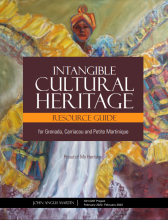Nestled in the warm waters of the eastern Caribbean, Grenada’s islands are home to a rich variety of cultural heritage shaped by African, European, and Indigenous influences rooted in its colonial history. While a first National Cultural Policy was established in 2012, the journey to actively identify and promote the country’s living heritage only gained momentum nearly a decade later, when the Grenada National Trust initiated a nationwide campaign to identify and raise awareness about living heritage. Activities included a media campaign, TV and radio broadcasts, social media programmes, public events, contests, and an open platform for public input. These efforts engaged over 100,000 people, including residents and the diaspora, fostering community participation in safeguarding Grenada’s cultural heritage.
What was the need?
The practice of many traditions in the islands of Grenada, Carriacou, and Petite Martinique, such as traditional fishing, storytelling, boatbuilding, straw weaving, drum making, traditional games, the observance of prayers and wakes, and many forms of community festivals and dances has declined due to globalization, rapid social changes, and interruption of intergenerational knowledge transfer. This has led to reduced community interest and awareness, particularly among younger generations, about the cultural significance of these expressions of living heritage and the importance of safeguarding them.
‘One of the most important things that stand out from the campaign was the passion with which the practitioners talked about their art. They were really passionate about how they expressed the different elements to us. There were also really happy that we were interested in recording what they had to say about their elements, because nobody had seemed to talk to them before.’
John Angus Martin, historian, archivist and heritage researcher, about community engagement.
‘I feel like we need to document more heritage and get involved the people who really make it move.’
Godfrey Luke, drummer, about living heritage documentation and transmission
What solutions were considered?
The Grenada National Trust, a non-profit organization, collaborated with ministries and partners to address the declining recognition of living heritage through a nationwide awareness campaign. This initiative targeted key stakeholders, including bearer communities, cultural organizations, educators, and media professionals. A year-long media campaign highlighted Grenada’s living heritage locally and within the diaspora, utilizing TV, radio, social media, billboards, school events, competitions, award ceremonies, branded materials, as well as an exhibition on intangible cultural heritage during the National Independence Day. The campaign was accompanied by the launch of an interactive open online platform and a resource guide.
This process was supported by the International Assistance from the 2003 Convention’s Intangible Cultural Heritage Fund (2021-2023).
‘As I became a more conscious citizen, my participation in Djab-Djab became a lot more serious. It now became a commitment, an expression of self, an expression of culture (…), ‘this is us’, an expression of the beauty of our people, not just of our culture but also of our psyche.’
Colin Dowe, practitioner, Djab-Djab, about awareness of culture
How did it work?
The media campaign proved to be an effective awareness-raising strategy, reaching over 100,000 persons from local communities, residents and Grenadian diaspora. Examples include billboards placed in different spots of Grenada, Carriacou and Petite Martinique displaying inventoried living heritage elements, a photo competition disseminated on social media, including a ’youth prize’, and the ‘Proud of my Heritage’ award ceremony, which recognized in March 2023 over fifty living heritage practitioners for their efforts in keeping their traditions alive, such as Maypole dancing, drumming and drum-making, Shortknee masquerade, string band, boat building, storytelling, dancing of the Flags & Cake, Djab Djab (traditional carnival masquerades), etc.
In addition, an online platform (link below) encouraged public engagement and networking around heritage elements, while an instant messaging group facilitated dialogue and resource sharing among partners and practitioners.
Finally, an ICH resource guide was made available online (see below), showcasing the rich variety of cultural expressions in order to recognize their broader recognition and appreciation by the present and future generations of Grenadians.
How was the community involved?
The Grenada National Trust took the necessary steps and measures to ensure broad participation among the local communities. Local community members have actively participated in consultations, interviews, and discussions, engaging openly in communication activities, through traditional and social media.
Contactos para compartir experiencias
Grenada National Trust
P.O. Box 3542, St. George’s, Grenada
Language for contact: English
+1(473) 407-1212
admin@grenadanationaltrust.org; heritagegrenada@gmail.com
Para saber más
- Videos about this experience
- Resource guide ‘Intangible cultural heritage resource guide for Grenada, Carriacou and Petite Martinique’

© The Grenada National Trust
Download the guide: inglés